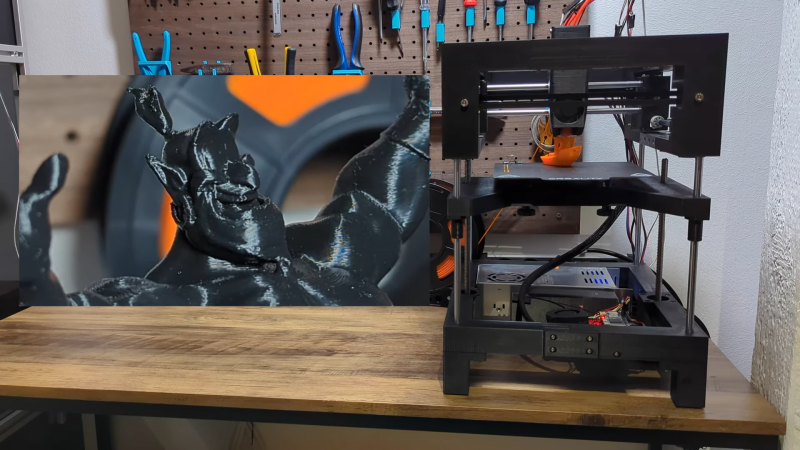Truth be told, we generally find speed sports to be a little boring. Whether it’s cars going around in circles for hours on end or swimmers competing to be a few milliseconds faster than everyone else, we just don’t feel the need for speed. Unless, of course, you’re talking about speedy 3D printers like “The 100”, which claims to produce high-quality prints in a tenth the time of an ordinary printer. In that case, you’ve got our full attention.
What makes [Matt the Printing Nerd]’s high-speed printer interesting isn’t the fact that it can do a “Speedboat Run” — printing a standard Benchy model — in less than six minutes. Plenty of printers can do the same thing much, much faster. The impressive part is that The 100 does it with a 3D-printed frame. In fact, most of the printer’s parts are 3d printed, a significant departure from most speed printer builds, which generally shy away from printed structural elements. [Matt]’s design also aims to keep the center of gravity of all the printer’s components within a very small area, which helps manage frame vibrations that limit print quality. The result is that the CoreXY gantry is capable of a speed of 400 mm/s and an eye-popping 100,000 mm/s² acceleration. What also sets [Matt]’s printer apart is that The 100 is designed to be a daily driver. It has a generous 165 mm x 165 mm print bed, which is far more useful than a bed that’s barely bigger than a standard Benchy.
The video below has much more details on the open-source build, plus some nice footage of some speed runs. The quality of the prints, even done at speed, is pretty impressive. Perhaps there is a point to speed sports after all.
















It’s like Tantillus but without the janky XY mechanism.
How hard was it to match the melted filament volume flow (in both rate and acceleration) to the movement of the printhead (again in rate and acceleration) ? If they’re mismatched in time by ??? you’ll end up with fat lines on deceleration of the printhead and skinny lines on acceleration. And given the high printhead speeds, I have to believe there’s more time spent accelerating and decelerating that is the norm for a typical printer.
Kudos on an impressive build.
Klipper’s pressure advance makes this not a problem. It’s only really an issue on cheap printers that either have hardware that marlin firmware doesn’t support for it’s pressure advance implementation called linear advance, or where the manufacturer has enabled the bare minimum of marlin features rather than spending the development time to get good results.
“What makes [Matt the Printing Nerd]’s high-speed printer interesting isn’t the fact that it can do a “Speedboat Run” — printing a standard Benchy model — in less than six minutes. Plenty of printers can do the same thing much, much faster.”
Sorry but I strongly disagree with the way this is framed. Very few printers are able to do a sub 6min Benchy, especially with such a nice finish quality. True, some heavily modded ones are able to “print” a sub 3min benchy, but all you get in the end is a stringy blob of plastic that resembles a boat [1]. To make a fair comparison, you have to look for “quality” speedboat races, and in this regard The 100’s seems to me one of the most impressive entries ever in this section of the “contest” [2]. For reference, the Bambu Labs machines, which are the fastest you can buy assembled today, churn out a similar benchy in about 17 minutes.
I guess what I want to say here is that if it prints reliably, this is not merely just a “high performance 3D printed printer”, it’s a very high performance printer overall possibly on par or even superior to almost any kind of FDM printer that you can find today, including industrial grade ones as well as DIY hobbyist ones that use metal parts and easily costs 10x more, like Voron or VzBot, at least when it comes to speed/quality. The fact that it has a 3D printed frame should only make this feat more impressive, instead of hiding it. In any case, kudos for the design, this looks like a very intersting machine :)
1: https://www.youtube.com/watch?v=a6XRs-g6ngw
2: https://www.youtube.com/watch?v=vso6lgTRSo0
These are impressive results. The 6 minute Benchy is ugly (it passes speedboat rules so whatever) but the 16 minute Benchy is great. I also like that it was designed to scale up more than Benchy size.
No credit to the rook or rook 180 which this is “inspired” on. Even the toolhead is a rookery. This is basically a mashup mod of those two printers.
He mentions it at 1:10ish in the video… But it would be nice if had mentioned the props.